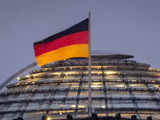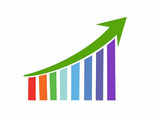Suggest a new Definition
Proposed definitions will be considered for inclusion in the Economictimes.com
What is 'Inflation'
Definition: Inflation is the percentage change in the value of the Wholesale Price Index (WPI) on a year-on year basis. It effectively measures the change in the prices of a basket of goods and services in a year. In India, inflation is calculated by taking the WPI as base.
Formula for calculating Inflation=
(WPI in month of current year-WPI in same month of previous year)
-------------------------------------------------------------------------------------- X 100
WPI in same month of previous year
Description: Inflation occurs due to an imbalance between demand and supply of money, changes in production and distribution cost or increase in taxes on products. When economy experiences inflation, i.e. when the price level of goods and services rises, the value of currency reduces. This means now each unit of currency buys fewer goods and services.
It has its worst impact on consumers. High prices of day-to-day goods make it difficult for consumers to afford even the basic commodities in life. This leaves them with no choice but to ask for higher incomes. Hence the government tries to keep inflation under control.
Contrary to its negative effects, a moderate level of inflation characterizes a good economy. An inflation rate of 2 or 3% is beneficial for an economy as it encourages people to buy more and borrow more, because during times of lower inflation, the level of interest rate also remains low. Hence the government as well as the central bank always strive to achieve a limited level of inflation.
Watch video: All that you wanted to know about inflation...
Related News
 Emerging market equities excluding China can outperform over next 3 years: Matt OrtonWe are finally seeing increased market breadth translate into increased price breadth and despite some of the heavyweight names being down in today's session, the overall market still held up okay and a lot of stocks did well.
Emerging market equities excluding China can outperform over next 3 years: Matt OrtonWe are finally seeing increased market breadth translate into increased price breadth and despite some of the heavyweight names being down in today's session, the overall market still held up okay and a lot of stocks did well. Revised data shows US GDP doubled over Q1The US economy experienced significant growth, expanding at a 3% annual rate last quarter, driven by strong consumer spending and business investment, according to an upgraded government report. This marked an improvement from the previous 2.8% rate. Inflation has also fallen sharply since 2022, and the Federal Reserve may soon cut interest rates.
Revised data shows US GDP doubled over Q1The US economy experienced significant growth, expanding at a 3% annual rate last quarter, driven by strong consumer spending and business investment, according to an upgraded government report. This marked an improvement from the previous 2.8% rate. Inflation has also fallen sharply since 2022, and the Federal Reserve may soon cut interest rates. China needs to boost consumption, lift nominal GDP, & stabilize debt-to-GDP ratio to break debt-inflation loopChina aims for 5% real GDP growth despite a struggling property sector by reallocating investment into manufacturing and infrastructure. However, this approach leads to deflationary pressures and rising debt-to-GDP ratios. Policymakers need to boost social security spending to increase consumption and escape the debt-deflation loop.
China needs to boost consumption, lift nominal GDP, & stabilize debt-to-GDP ratio to break debt-inflation loopChina aims for 5% real GDP growth despite a struggling property sector by reallocating investment into manufacturing and infrastructure. However, this approach leads to deflationary pressures and rising debt-to-GDP ratios. Policymakers need to boost social security spending to increase consumption and escape the debt-deflation loop. Gold gains as investors zero in on Fed cuts, inflation dataGold prices gained on Thursday, fuelled by strong expectations of a Federal Reserve rate cut in September with investors focusing on U.S. inflation data for further insights on the potential size of the cut.
Gold gains as investors zero in on Fed cuts, inflation dataGold prices gained on Thursday, fuelled by strong expectations of a Federal Reserve rate cut in September with investors focusing on U.S. inflation data for further insights on the potential size of the cut. German inflation falls below 2% for first time since 2021German inflation dropped to its lowest level in over three years in August, marking a significant decline to 1.9 percent from 2.3 percent in July. This fall strengthens the likelihood of another interest rate cut by the European Central Bank next month. The slowdown was driven by a decline in energy prices.
German inflation falls below 2% for first time since 2021German inflation dropped to its lowest level in over three years in August, marking a significant decline to 1.9 percent from 2.3 percent in July. This fall strengthens the likelihood of another interest rate cut by the European Central Bank next month. The slowdown was driven by a decline in energy prices. US economic growth for last quarter is revised up to a solid 3% annual rateThe U.S. economy experienced a robust 3% annual growth rate in the last quarter, driven by strong consumer spending and business investment. The Commerce Department revised its earlier estimate from 2.8% to 3%. Despite high interest rates, the economy shows resilience. Inflation has significantly dropped, and the Federal Reserve aims to lower interest rates in the near future to support the job market.
US economic growth for last quarter is revised up to a solid 3% annual rateThe U.S. economy experienced a robust 3% annual growth rate in the last quarter, driven by strong consumer spending and business investment. The Commerce Department revised its earlier estimate from 2.8% to 3%. Despite high interest rates, the economy shows resilience. Inflation has significantly dropped, and the Federal Reserve aims to lower interest rates in the near future to support the job market. Retail inflation rates for farm, rural workers ease in JulyRetail inflation for farm and rural workers in India showed a decline in July, registering at 6.17 per cent and 6.20 per cent, respectively. This marks a fall from June's rates of 7.02 per cent and 7.04 per cent. The All-India Consumer Price Index for Agricultural and Rural Labourers increased by 10 points each, reaching 1,290 and 1,302.
Retail inflation rates for farm, rural workers ease in JulyRetail inflation for farm and rural workers in India showed a decline in July, registering at 6.17 per cent and 6.20 per cent, respectively. This marks a fall from June's rates of 7.02 per cent and 7.04 per cent. The All-India Consumer Price Index for Agricultural and Rural Labourers increased by 10 points each, reaching 1,290 and 1,302. India’s heat is now a better predictor of food prices than rainTracking rising temperatures is becoming a better way to forecast food inflation in India than relying on rain patterns, according to HSBC. The link between extreme heat and the price of agricultural commodities has strengthened over the past decade. Inflation remains above the Reserve Bank of India’s target due to volatile food costs.
India’s heat is now a better predictor of food prices than rainTracking rising temperatures is becoming a better way to forecast food inflation in India than relying on rain patterns, according to HSBC. The link between extreme heat and the price of agricultural commodities has strengthened over the past decade. Inflation remains above the Reserve Bank of India’s target due to volatile food costs. Fed's Bostic: it is 'time to move' on rate cuts, but wants to be sureWith inflation lowering and unemployment rising more than anticipated, Federal Reserve Bank of Atlanta President Raphael Bostic indicated it might be time for rate cuts. However, he emphasized the need for confirmation from upcoming jobs and inflation reports due before their September meeting to avoid the need to reverse decisions.
Fed's Bostic: it is 'time to move' on rate cuts, but wants to be sureWith inflation lowering and unemployment rising more than anticipated, Federal Reserve Bank of Atlanta President Raphael Bostic indicated it might be time for rate cuts. However, he emphasized the need for confirmation from upcoming jobs and inflation reports due before their September meeting to avoid the need to reverse decisions. Dollar holds gains ahead of US inflation testThe dollar steadied amid recent steep losses, as traders await the core PCE price index, a key U.S. inflation measure, due Friday. Market reactions remain muted with currencies mostly rangebound. Analysts believe the upcoming data won't significantly alter Federal Reserve rate expectations unless it significantly deviates from forecasts.
Dollar holds gains ahead of US inflation testThe dollar steadied amid recent steep losses, as traders await the core PCE price index, a key U.S. inflation measure, due Friday. Market reactions remain muted with currencies mostly rangebound. Analysts believe the upcoming data won't significantly alter Federal Reserve rate expectations unless it significantly deviates from forecasts.